

Mermaids and shells never tasted better than in these hand-decorated cookies from Eleni’s NYC.
|
 |

Home / Product Reviews
Gourmet News & Views
July 2006
Click here to return to current month’s news
7.31.06
American Cheese Society Anoints 2006 Winners. If you love cheddar, get on the phone to your cheesemonger. Buttery, small batch, cave-aged Cabot Clothbound 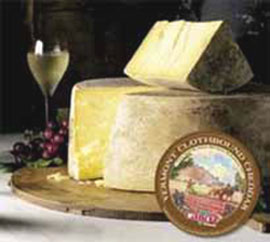 Cheddar with its caramel undertones has won Best Of Show. That makes it the best cheese in America, according to the American Cheese Society judges. It’s a limited production cheese, and if you can’t find it locally, it’s available at Artisanal Cheese and Murray’s. But if you can’t get it (only 250 wheels were made), console yourself with the other 273 first, second and third place winners in 22 categories and 91 subcategories, spanning everything from Fresh Unripened Cheeses to Cheeses Flavored with Crushed or Whole Peppercorns or Savory Spices. Mozzarella Fresca’s products, which we recommended in our weekly Top Pick newsletter in April, won “Best Marinated Cheese From Cow’s Milk” and ”Best Cheese Spread” for their Dolce caramel-flavored mascarpone. Another Top Pick Of The Week, Meyenberg Goat Milk Butter, won first place in its category. Other NIBBLE-recommended products to receive ribbons included Cowgirl Creamery’s Red Hawk Washed Rind Cheese and Redwood Hill Farm yogurt; plus quite a few cheeses recommended by Stephanie Zonis in her monthly cheese column, Whey To Go. Stephanie will be reporting on cheese trends from the show in the August issue of THE NIBBLE. The competition included 157 producers from 28 states and two Canadian provinces, who entered a record 941 cheeses, almost 200 more than last year’s record 749. If you want to attend next July’s competition, in Burlington, Vermont, to see if they top 1000 cheeses, you need to join the American Cheese Society. But, don’t dawdle—this year’s event was sold out. In theory you do get to taste most of the cheeses, although who among us is enough of a “big cheese” to taste them all in just three days? Cheddar with its caramel undertones has won Best Of Show. That makes it the best cheese in America, according to the American Cheese Society judges. It’s a limited production cheese, and if you can’t find it locally, it’s available at Artisanal Cheese and Murray’s. But if you can’t get it (only 250 wheels were made), console yourself with the other 273 first, second and third place winners in 22 categories and 91 subcategories, spanning everything from Fresh Unripened Cheeses to Cheeses Flavored with Crushed or Whole Peppercorns or Savory Spices. Mozzarella Fresca’s products, which we recommended in our weekly Top Pick newsletter in April, won “Best Marinated Cheese From Cow’s Milk” and ”Best Cheese Spread” for their Dolce caramel-flavored mascarpone. Another Top Pick Of The Week, Meyenberg Goat Milk Butter, won first place in its category. Other NIBBLE-recommended products to receive ribbons included Cowgirl Creamery’s Red Hawk Washed Rind Cheese and Redwood Hill Farm yogurt; plus quite a few cheeses recommended by Stephanie Zonis in her monthly cheese column, Whey To Go. Stephanie will be reporting on cheese trends from the show in the August issue of THE NIBBLE. The competition included 157 producers from 28 states and two Canadian provinces, who entered a record 941 cheeses, almost 200 more than last year’s record 749. If you want to attend next July’s competition, in Burlington, Vermont, to see if they top 1000 cheeses, you need to join the American Cheese Society. But, don’t dawdle—this year’s event was sold out. In theory you do get to taste most of the cheeses, although who among us is enough of a “big cheese” to taste them all in just three days?
New Designer Chocolate Arrives In The U.S. Israel’s chic chocolatier, Max Brenner, has arrived in the U.S. with a splash, opening a glamorous chocolate boutique  and café at 841 Broadway in New York City (at 13th Street). Another store will open next month at 141 Second Avenue at 9th Street. With the tag line “Chocolate By The Bald Man,” one would not expect such clever and ebullient packaging—or such a young and attractive bald man! Brenner, a European-trained pastry chef, makes dazzling pastries and offers numerous “have-to-be-there” fun concepts in snacks, like an ice cream bar where you dip plain vanilla pops-on-a-stick into the coatings and toppings of your choice. The breakfast, lunch and dinner menu is mindful of the observant and has tasty low-calorie options among the “regular” fare. The chocolates are made in Israel and are kosher; the restaurant is not. The stores have no e-commerce at this time, but some items have been available since 2000 at Chocosphere.com (the offering changes based on shipments, so keep checking). and café at 841 Broadway in New York City (at 13th Street). Another store will open next month at 141 Second Avenue at 9th Street. With the tag line “Chocolate By The Bald Man,” one would not expect such clever and ebullient packaging—or such a young and attractive bald man! Brenner, a European-trained pastry chef, makes dazzling pastries and offers numerous “have-to-be-there” fun concepts in snacks, like an ice cream bar where you dip plain vanilla pops-on-a-stick into the coatings and toppings of your choice. The breakfast, lunch and dinner menu is mindful of the observant and has tasty low-calorie options among the “regular” fare. The chocolates are made in Israel and are kosher; the restaurant is not. The stores have no e-commerce at this time, but some items have been available since 2000 at Chocosphere.com (the offering changes based on shipments, so keep checking).
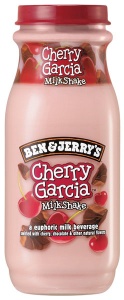 More Moos From Vermont. Ben & Jerry’s has launched grab & go milkshakes in three popular flavors: Chocolate Fudge Brownie, Chunky Monkey and Cherry Garcia. The self-acclaimed “euphoric milk beverages” are available at grocery and convenience stores nationwide in eight-ounce glass bottles. The milkshakes are made with “naturally good ingredients,” including milk that is rBGH-free. More Moos From Vermont. Ben & Jerry’s has launched grab & go milkshakes in three popular flavors: Chocolate Fudge Brownie, Chunky Monkey and Cherry Garcia. The self-acclaimed “euphoric milk beverages” are available at grocery and convenience stores nationwide in eight-ounce glass bottles. The milkshakes are made with “naturally good ingredients,” including milk that is rBGH-free.
rBGH is the abbreviation for Recombinant Bovine Growth Hormone, a genetically engineered hormone that is injected into dairy cows to increase their milk production. Evidence is accumulating that rBGH may promote breast and prostate cancer in humans who drink milk from rBGH-treated cows.
In other “moos,” a Nebraska dairy, seeking to capitalize on consumer interest in rBGH-free milk, has introduced “Original Milk,” a new branded milk from cows that are free of the hormone. It is marketed by Original Foods, LLC, a company which organized last fall to serve the growing national demand for organic, natural and local foods. The company plans to expand its offerings to other food products, including cheese, beef and specialty milk products that are designed to address health conditions. If Original Foods expands beyond Nebraska, it will seek partners that can offer local products within given regions. Two of the three partners in Original Foods are the founders and president and chief scientific officer, respectively, of GeneSeek, a global biotechnology firm is the leader in providing DNA-based discovery and diagnostics to the plant and animal breeding industry.
A Healthier Windy City? Chicago is considering legislation that would make it illegal for restaurants to cook with oils that contain trans fats. Alderman Edward M. Burke is the force behind the proposal which has drawn criticism from many, including Chicago Mayor Richard M. Daley. Burke believes that it would be a step in the right direction for Chicago, which was recently named “America’s Fattest City” by Men’s Fitness magazine. If the proposal becomes law, Chicago would be the first major city to institute such a policy, and restaurants that continued the use of “artificial trans fats” would be fined between $200 to $1000 dollars a day. We’re glad to see that the food-focused legislators of Chicago can propose legislation that impacts millions of people for good cause—their health—instead of taking up the legislators’ time to outlaw the sales of the gourmet delicacy foie gras, which—let us guess—maybe 5,000 residents eat there with any frequency—because of unsupported allegations that the way the geese have been fed for millennia is “cruel.”
Chocolate Feeds The Brain and Heart. Evidently people don’t have time for a bowl of cereal at home, but they do have time to grab breakfast at quickservice chains, some of which report an increase of 30% to 35% in breakfast sales over the past year. Perhaps it’s the temptation of the new steak and egg breakfast burrito and breakfast burger at Carl’s Jr.; or revamped breakfast menu at Chick-Fil-A, which includes a yeast roll with honey butter with chicken nuggets inside; two flavors of chicken burritos; and a chicken, egg and cheese bagel sandwich. Instead, breakfasters should consider a cup of dark hot chocolate—light on the sugar, please. 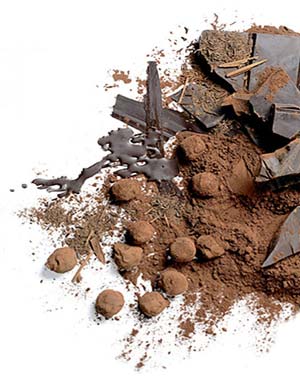 A team of U.S. and German researchers have found that that flavanol-rich cocoa has circulatory health benefits including brain and cardiovascular blood-flow improvement. Two independent studies, one in a healthy elderly population and another in young healthy women, demonstrate that the consumption of flavanol-rich cocoa can increase blood flow to the brain, according to the Journal of Cardiovascular Pharmacology. The scientists found that the regular consumption of flavanol-rich cocoa resulted in a significant increase in blood flow that may improve vascular function in this postmenopausal women population with higher cardiovascular risk; and in general may also reduce the cascade of events that can lead to vascular damage. Who wouldn’t enjoy a soul-satisfying cup of hot chocolate every morning? Buy top-quality cocoa powder, make a big pot in advance with 1% or 2% milk, use a small amount of sugar (or none at all, and then use artificial sweetener) and heat it in the microwave for 60 seconds. You’ve got flavonoids, calcium, something warm and filling—and grab a quick bowl of cereal while you’re at it. A team of U.S. and German researchers have found that that flavanol-rich cocoa has circulatory health benefits including brain and cardiovascular blood-flow improvement. Two independent studies, one in a healthy elderly population and another in young healthy women, demonstrate that the consumption of flavanol-rich cocoa can increase blood flow to the brain, according to the Journal of Cardiovascular Pharmacology. The scientists found that the regular consumption of flavanol-rich cocoa resulted in a significant increase in blood flow that may improve vascular function in this postmenopausal women population with higher cardiovascular risk; and in general may also reduce the cascade of events that can lead to vascular damage. Who wouldn’t enjoy a soul-satisfying cup of hot chocolate every morning? Buy top-quality cocoa powder, make a big pot in advance with 1% or 2% milk, use a small amount of sugar (or none at all, and then use artificial sweetener) and heat it in the microwave for 60 seconds. You’ve got flavonoids, calcium, something warm and filling—and grab a quick bowl of cereal while you’re at it.
Photo: 75% cacao truffles and chocolate from Vere.
New Product Watch: Kashi Entrees Bring Fresh to Frozen. Natural foods company Kashi, better known for their cereals, is releasing a new line of frozen entrees aimed to be healthier than the typical frozen meal. The ten-ounce meals come in six flavors: Black Bean Mango (vegetarian), Sweet & Sour Chicken, Southwest Style Chicken, Lime Cilantro Shrimp, Lemon Rosemary Chicken and Chicken Pasta Pomodoro. Each dish is between 240 and 380 calories, has between 8 and 19 grams of protein, and offers 5 to 7 grams of fiber. The line is all natural, preservative-free and minimally processed, and all except for the Chicken Pasta Pomodoro they include Kashi’s original pilaf, their signature blend of seven whole grains plus sesame (the pasta has whole wheat penne instead).
7.24.06
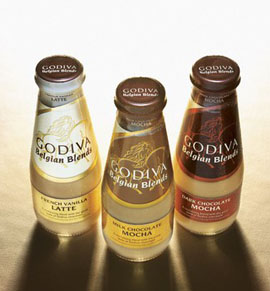 Now You Can Drink Godiva While You Eat It. If you’d like your latte more upscale and chocolatey, you need only wait a few more days for Godiva Belgian Blends. Beginning July 31 the chic new beverage will be available in Dark Chocolate Mocha, Milk Chocolate Mocha and French Vanilla Latte, in stylish 9.5 fl. oz. glass bottles. You don’t need to go to the chocolate store: they’ll be at convenience stores, supermarkets and other retailers, in singles and four packs. Godiva’s marketing partner is beverage titan Coca-Cola North America. According to a company press release, Godiva Belgian Blends will be marketed as a revitalizing experience “more decadent than just plain coffee.” Decadent—are they sure? In our book, the word “decadent,” which means providing unrestrained gratification, does not apply to a beverage. Enjoying a mocha latte is hardly equivalent to an eating orgy or even polishing off an entire box of Godiva chocolate. Nevertheless, you can probably enjoy a bottle or two of Godiva Belgian Blends without turning into a [truly decadent] character from Fellini’s Satyricon. Now You Can Drink Godiva While You Eat It. If you’d like your latte more upscale and chocolatey, you need only wait a few more days for Godiva Belgian Blends. Beginning July 31 the chic new beverage will be available in Dark Chocolate Mocha, Milk Chocolate Mocha and French Vanilla Latte, in stylish 9.5 fl. oz. glass bottles. You don’t need to go to the chocolate store: they’ll be at convenience stores, supermarkets and other retailers, in singles and four packs. Godiva’s marketing partner is beverage titan Coca-Cola North America. According to a company press release, Godiva Belgian Blends will be marketed as a revitalizing experience “more decadent than just plain coffee.” Decadent—are they sure? In our book, the word “decadent,” which means providing unrestrained gratification, does not apply to a beverage. Enjoying a mocha latte is hardly equivalent to an eating orgy or even polishing off an entire box of Godiva chocolate. Nevertheless, you can probably enjoy a bottle or two of Godiva Belgian Blends without turning into a [truly decadent] character from Fellini’s Satyricon.
NIBBLE Picks Take Top Awards At Fancy Food Show. The annual NASFT Product Awards were recently bestowed in 21 categories, and the winners of ten categories happened to be products previously selected by THE NIBBLE™.
Whoopass Now At Kmart. Uber-hip Jones Soda has been tapped by Kmart, and will soon be available in all 1,450 U.S. stores. The Seattle-based beverage manufacturer, known for its Jones Soda, Jones Energy, Jones Organics, Jones Naturals and Whoopass brands, is known for its innovative labeling that incorporates always-changing photos sent in from its consumers. The company put itself on the world map in 2003 with its Turkey & Gravy Soda, launched prior to Thanksgiving. Their 2004 holiday pack included a whole dinner’s worth of sodas: Green Bean Casserole Soda, Mashed Potato & Butter Soda, Fruitcake Soda, Cranberry Soda and Turkey & Gravy Soda. If you didn’t drink yours, it sells on e-Bay for much more than the original price (or the gustatory experience).
It Melts In Your Mouth—Hooray! Chocolate is not widely consumed in the tropics, even though that’s where most of the world’s cacao is grown. The reason: It's too hot—chocolate bars in the tropical rainforest would melt. According to an article on LiveScience.com, researchers in Nigeria believe they are close to achieving a heat-resistant chocolate that actually tastes like chocolate. By mixing cornstarch with chocolate, S.O. Ogunwolu and C.O. Jayeola, food scientists at the Cocoa Research Institute of Nigeria, have produced a heat-resistant chocolate that they say compares favorably with conventional milk chocolate. The product stays firm up to 122°F. Most brands of chocolate melt at temperatures between 77°F to about 91°F.
Food scientists have been working on the problem since World War II. During Operation Desert Storm, Hershey’s tested a high-temperature chocolate capable of withstanding 140°F temperatures. It was dubbed the “Desert Bar,” but troop reactions to its taste were mixed. “They don't melt in your mouth,” said Richard Hartel, a food engineer at the University of Wisconsin-Madison, who was not involved in the Nigerian study. “You have to chew it, and that’s what leads to a waxy or chewy characteristic.”
The corn starch chocolate doesn’t seem to have this problem—it melts in your mouth 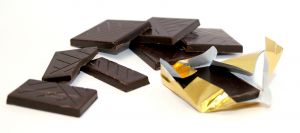 like regular chocolate. In taste tests conducted by the Nigerian researchers, people rated the new chocolate as being similar to milk chocolate in color, taste, smoothness and overall acceptability. It was found to be slightly less sweet than milk chocolate, however. (This would be seen as a benefit to dark chocolate-lovers!) However, the Nigerian team isn’t concerned with how it compares against “real” milk chocolate: their target market, which does not have the luxury of air conditioning, currently doesn’t eat chocolate at all. Photo: The real stuff. Tasters say they can’t tell the difference. like regular chocolate. In taste tests conducted by the Nigerian researchers, people rated the new chocolate as being similar to milk chocolate in color, taste, smoothness and overall acceptability. It was found to be slightly less sweet than milk chocolate, however. (This would be seen as a benefit to dark chocolate-lovers!) However, the Nigerian team isn’t concerned with how it compares against “real” milk chocolate: their target market, which does not have the luxury of air conditioning, currently doesn’t eat chocolate at all. Photo: The real stuff. Tasters say they can’t tell the difference.
Yogurt Growth Spurt. Yogurt sales continue to grow at a respectable pace, while its dairy siblings, natural cheese and ice cream/sorbet are a point below flat in sales, according to quarterly information from Information Resources, Inc. The category, including both cup yogurt and yogurt drinks, is growing at 5.5% versus 4% for the entire grocery industry. Yoplait, the industry leader, is up 12% versus a year ago and Stonyfield Farm, the #3 player behind Yoplait, is up a whopping 22.5% (no doubt reflecting the growing consumer interest in organics). New Hampshire-based Stonyfield Farm is 85% owned by France’s Groupe Danone, whose Dannon USA unit is the #2 American yogurt brand.
LUNA® Bar Goes Organic. Luna, the makers of the Whole Nutrition Bar for Women™, have launched the LUNA Sunrise™, the first organic nutrition bar created 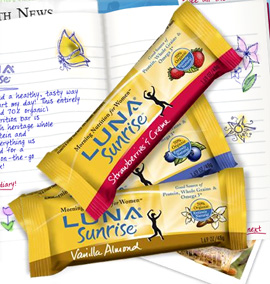 as a breakfast replacement for women on-the-go. While most women are well aware of the importance of a healthy breakfast, a recent national LUNA study showed that one-third skip regularly skip breakfast due to time challenges or lack of healthy choices, and 56 percent of women eat breakfast on-the-run at least twice a week. The 180-calorie LUNA Sunrise bars, in Blueberry Yogurt, Strawberries & Creme and Vanilla Almond, have 8g of protein and 5g of fiber to curb hunger and sustain energy, plus added calcium, folic acid, iron, and antioxidants (vitamins A, C, and E). Each bar contains as much calcium as a glass of milk, plus Vitamin D to help absorb calcium. The bars are made of a unique blend of organic heritage (or heirloom) whole grains including amaranth, quinoa, oats and barley, which contain more nutrients than other whole grains. The bars, which are made with 70 percent organic ingredients, also contain organic flaxseed, which provides Omega 3’s. The bars are available nationwide at grocery, natural, convenience, drug and sports specialty stores with a suggested retail price of $1.29. LUNA is made by the manufacturers of CLIF® Bar. To learn more about the different levels of organic certification, click here. as a breakfast replacement for women on-the-go. While most women are well aware of the importance of a healthy breakfast, a recent national LUNA study showed that one-third skip regularly skip breakfast due to time challenges or lack of healthy choices, and 56 percent of women eat breakfast on-the-run at least twice a week. The 180-calorie LUNA Sunrise bars, in Blueberry Yogurt, Strawberries & Creme and Vanilla Almond, have 8g of protein and 5g of fiber to curb hunger and sustain energy, plus added calcium, folic acid, iron, and antioxidants (vitamins A, C, and E). Each bar contains as much calcium as a glass of milk, plus Vitamin D to help absorb calcium. The bars are made of a unique blend of organic heritage (or heirloom) whole grains including amaranth, quinoa, oats and barley, which contain more nutrients than other whole grains. The bars, which are made with 70 percent organic ingredients, also contain organic flaxseed, which provides Omega 3’s. The bars are available nationwide at grocery, natural, convenience, drug and sports specialty stores with a suggested retail price of $1.29. LUNA is made by the manufacturers of CLIF® Bar. To learn more about the different levels of organic certification, click here.
7.17.06
Taste 160,000 Specialty Foods In 3 Days. That was the challenge presented to some 25,000 buyers and journalists—including the editors of THE NIBBLE™—at the 52nd annual Summer Fancy Food Show held last week in New York City. The industry’s largest U.S. event attracted exhibitors from 71 countries. Click here to read our report on the “best of show.”
NIBBLE Editorial Director On “America Eats.” Karen Hochman, editorial director of the NIBBLE, appeared in last week’s segment of The History Channel’s popular series, America Eats. The segment on “Salty Snacks” aired Thursday, July 13 at 10 p.m. You can catch it in re-runs. Learn about the history of popcorn, potato chips and other favorite salty snacks.
Gluten-Free Foods On The Rise. The gluten-free food and beverages market is growing rapidly and is expected to reach $1.7 billion by 2010, up from its current $700 million, according to a new study 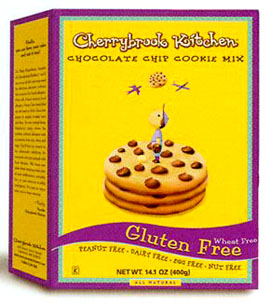 released by Packaged Facts. Gluten-free products have seen sales soar in recent years due to an increase in the number of individuals diagnosed with Celiac disease, a gluten intolerance illness. The market had an annual compound growth rate of 27 percent from 2001 to 2006, a rate that is forecasted to drop slightly to 25 percent through 2010. A lack of set regulations for gluten-free products has kept some manufacturers from entering the industry, but more activity is anticipated when the FDA releases its definition of “gluten-free” in 2008. The demand for gluten-free foods was evident at the Fancy Food Show, where new specialty foods producers of gluten-free crackers and cake mixes exhibited for the first time; and many other products, including those which traditionally have no grain in them (like jam, ice cream and soda) proclaimed “gluten-free” on the front of their packages. Shown above is one of our top picks from the Fancy Food show, the chocolate chip cookies from Cherrybook Kitchen’s gluten-free line of cookie, cake and pancake mixes. released by Packaged Facts. Gluten-free products have seen sales soar in recent years due to an increase in the number of individuals diagnosed with Celiac disease, a gluten intolerance illness. The market had an annual compound growth rate of 27 percent from 2001 to 2006, a rate that is forecasted to drop slightly to 25 percent through 2010. A lack of set regulations for gluten-free products has kept some manufacturers from entering the industry, but more activity is anticipated when the FDA releases its definition of “gluten-free” in 2008. The demand for gluten-free foods was evident at the Fancy Food Show, where new specialty foods producers of gluten-free crackers and cake mixes exhibited for the first time; and many other products, including those which traditionally have no grain in them (like jam, ice cream and soda) proclaimed “gluten-free” on the front of their packages. Shown above is one of our top picks from the Fancy Food show, the chocolate chip cookies from Cherrybook Kitchen’s gluten-free line of cookie, cake and pancake mixes.
A California Mozzarella Is Named Best In The World. The greatest mozzarella in the world comes not from Italy, but from California! Recent NIBBLE Top Pick Of The Week Mozzarella Fresca has made history as the first U.S. fresh mozzarella producer to win a gold medal at World Cheese Awards, the world’s most prestigious international cheese event, held annually in London. The top cheese producers from the U.S., Europe, New Zealand, Australia and South Africa competed. “The prestige of winning Gold at the World Cheese Awards is close to taking Gold in the Olympics,” according to Bob Farrand of the U.K. Cheese Guild and chairman of the contest. A French sheep’s milk cheese from the Agour Fromagerie in the Pays Basque region won title of World Champion. The Fromagerie, founded in 1981 by Jean Etcheleku and run by him and his son Peio, won the top prize in 2002 for their Petit Agour sheep’s milk cheese and also have won 11 other medals for their products, including two gold. Judging is no easy job: 120 experts from around the world judged a total of 1542 cheeses over two days. For more information, read our story on the winners.
This week, the American Cheese Society convenes in Portland, Oregon, for another world-class judging. NIBBLE editor Stephanie Zonis is in attendance, and we’ll give a topline report in next week’s Gourmet News and full review in next month’s issue.
Product Watch: Kettle Bakes Pretzel Chips. One of our favorite potato 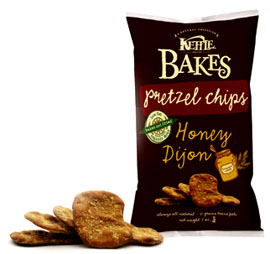 chips, Kettle™ Brand, is about to move into new territory—pretzel land—with a line of Bakes Pretzel Chips, flat-shaped baked pretzels (actually, the same curved shape as their potato chips), made with organic flour. Three flavors, Original, Fully Loaded (think of an “everything” bagel) and Honey Dijon debuted to the trade at Expo West, the industry’s largest natural products show, in April and will be showing up on store shelves this month. We think they’re a great idea, combining excellent pretzel flavor with a perfect shape for dipping. Our favorite flavor, Honey Dijon, actually requires no dip—it tastes as delicious as a pretzel dipped in honey mustard—and there’s no mustard to drip on anything! chips, Kettle™ Brand, is about to move into new territory—pretzel land—with a line of Bakes Pretzel Chips, flat-shaped baked pretzels (actually, the same curved shape as their potato chips), made with organic flour. Three flavors, Original, Fully Loaded (think of an “everything” bagel) and Honey Dijon debuted to the trade at Expo West, the industry’s largest natural products show, in April and will be showing up on store shelves this month. We think they’re a great idea, combining excellent pretzel flavor with a perfect shape for dipping. Our favorite flavor, Honey Dijon, actually requires no dip—it tastes as delicious as a pretzel dipped in honey mustard—and there’s no mustard to drip on anything!
America’s Winemakers Facing Heat from Global Warming. According to a study presented at the Proceedings of the National Academy of Sciences, global warming could seriously damage America’s multi-billion dollar wine industry. Grapes in areas such as California’s Napa and Sonoma Valleys have been suffering due to an increase in the frequency of very hot days. Noah Diffenbaugh of Purdue University’s Department of Earth and Atmospheric Sciences explained that grapes for premium wines require climate consistency. When temperatures rise above 95°F they have trouble maintaining photosynthesis and some of their sugars can break down. While the report is unsettling for some California vintners, it also shows that global warming could potentially improve grape growing conditions in areas previously unsuitable for viticulture, such as parts of the Northeast and Northwest. Diffenbaugh notes, however, that those areas are prone to higher humidity, which could cause an increase in fungus and other grape growing problems and would likely make winemaking in those areas very pricey.
Foie Gras Countdown And Commentary. Chicago foodies are bracing themselves for the ban on the sale of foie gras, beginning August 22nd. Sales of duck and goose liver within metropolitan Chicago have reportedly increased dramatically, indicating that more than a few people will miss the controversial delicacy once it is gone. California is the only other state that has banned foie gras, although New York, Oregon, Hawaii and Massachusetts all have similar ordinances pending. Chicago foie gras lovers shouldn’t give up hope yet, however. D’Artagnan, a major national purveyor of foie gras is considering litigation against the city of Chicago. They believe that the decision to ban foie gras was based on misinformation, and they are not alone. Michael Ginor, president of Hudson Valley Foie Gras, says that the Chicago City Council has “ignored the American Veterinarian Association’s research on foie gras production and have not taken steps to see how it is produced. If they had, they would see there is nothing inhumane about foie gras production.”
Part of the reason this has become such a hot issue in Chicago, reported industry trade magazine Gourmet News, is the added attention it has given the city’s 49th Ward Alderman Joe Moore, who championed the ordinance. Moore said the reason foie gras is being banned is due to its “shocking” production methods. “It involves animal torture, and that’s something, as a society, we should not support,” he said.
When the ordinance goes into effect this August, the prohibition against the sale of foie gras will carry a fine of no less than $250 for each offense. Ginor said it sets a bad precedent for the government to interfere with what people can eat. “If other city councils follow through on similar legislation, the public will be denied this 5,000-year-old delicacy,” he said. “I hope to see challenges mounted against this.”
We have seen foie gras farms—we don’t know if Alderman Moore can say the same—and can testify that no “animal torture” is involved. It is an artisanal craft and conditions are far more humane than large-scale meat production facilities (see The Meatrix). The website and direct mail we have seen from PETA activists suggests horrors that no legitimate news source has been able to verify.
We find it interesting that in choosing to dictate what Americans can eat, animal activists have thrown their energies against a tiny group of specialty food producers. The percentage of people who eat foie gras is minute, so all of the energy spent getting the public to sign petitions and legislators to enact foie gras legislation impacts very few animals. On the other hand, the number of people who eat lobster and crab is significant. One might logically think that the same energy could better go into saving the millions of crustaceans that are plunged live into boiling water—a far greater torture than having a feeding tube put down one’s throat.
However, activists and legislators who want to make a mark can far more easily do it by trampling a small group that few people care about that produces a foreign-origin food that few people have ever tasted (and can’t even pronounce), that is sold in limited quantity in small, specialty stores and restaurants in a few American cities. It takes far more effort—and perhaps bravery—to exercise one’s principles by taking on the fishing industry, huge restaurant chains and burly lobstermen and millions of diners nationwide to whom a lobster dinner is their right as Americans.
7.10.06
Toast of the Town. California caviar farmers are beginning to reap the benefits of the 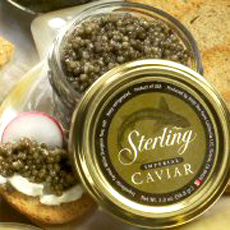 international ban on caviar exports. Sterling Caviar, a sturgeon farm based in Sacramento County, California, plans on producing 18,000 pounds of caviar this year. Twelve years ago, the company was harvesting just thirty pounds annually. California has great potential as a farmed caviar-producing region, as its climate allows for caviar to be harvested several times a year, as opposed to just during the spring (warm temperatures are required for the harvest). Though the quality of California caviar is very good, it’s not anything like beluga…yet. As more money and research is introduced into American caviar production, its value in terms of both price and taste is sure to increase. To find out everything else you’ve ever wanted to know about buying and serving caviar, click here for THE NIBBLE'S caviar articles. international ban on caviar exports. Sterling Caviar, a sturgeon farm based in Sacramento County, California, plans on producing 18,000 pounds of caviar this year. Twelve years ago, the company was harvesting just thirty pounds annually. California has great potential as a farmed caviar-producing region, as its climate allows for caviar to be harvested several times a year, as opposed to just during the spring (warm temperatures are required for the harvest). Though the quality of California caviar is very good, it’s not anything like beluga…yet. As more money and research is introduced into American caviar production, its value in terms of both price and taste is sure to increase. To find out everything else you’ve ever wanted to know about buying and serving caviar, click here for THE NIBBLE'S caviar articles.
Green, White, and…Blue Tea? New Leaf, the bottled iced tea company, will add two new teas this month with the introduction of its Blue Tea line. The flavors, Blue Tea with Raspberry and Blue Tea with Lemon, join the company’s existing selection of green and white teas. The “blue” tea is actually oolong, a partially fermented tea that has a bluish tint in its dried form and has been linked to a number of health benefits such as lowering cholesterol and aiding in digestion. Like all New Leaf teas, the Blue Teas are all natural, sweetened with evaporated cane juice, and 70 calories per serving; and will be available for purchase at specialty, gourmet, and health food stores. For more on the wide world of tea and its health benefits, explore THE NIBBLE’S Tea Section.
Somewhat Good News for Soft Drink Fans. According to a panel of scientists at the University of North Carolina, high-fructose corn syrup (HFCS) may not be as bad as previously thought. The corn derivative sweetener, which has been called everything from “the Devil’s candy” to “a sinister invention,” has been linked to obesity since it was introduced in the 1970s. But now a scientific panel created to provide clear guidelines to consumers about the nutritional risks of beverages says that there is no evidence that high-fructose corn syrup is any worse for you than regular white sugar. 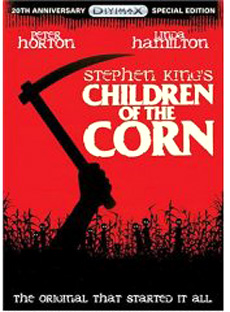 Their findings showed that our bodies treat both sweeteners the same way, and that regular sugar actually contains more fructose than high-fructose corn syrup. The panel of scientists also suggested that the public’s vilification of high-fructose corn syrup is a result of a desire to simplify a complex national health problem. The sweetener is popular with large companies, especially soda manufacturers, because it can be bought at a cost up to seventy percent less than regular sugar. As Americans have become more health-conscious however, high-fructose corn syrup’s popularity has faltered. Annual per-capita consumption of the sweetener is down 7 percent, to 59.2 pounds in 2005, from its peak of 63.7 pounds in 1999, according to the Agriculture Department. Even if high-fructose corn syrup and sugar are treated as equals by our bodies, our taste buds will never agree. And calories still count—HFCS, corn syrup, honey, or molasses. Click here for THE NIBBLE’S guide to soft drinks made reduced quantities of natural cane sugar. Their findings showed that our bodies treat both sweeteners the same way, and that regular sugar actually contains more fructose than high-fructose corn syrup. The panel of scientists also suggested that the public’s vilification of high-fructose corn syrup is a result of a desire to simplify a complex national health problem. The sweetener is popular with large companies, especially soda manufacturers, because it can be bought at a cost up to seventy percent less than regular sugar. As Americans have become more health-conscious however, high-fructose corn syrup’s popularity has faltered. Annual per-capita consumption of the sweetener is down 7 percent, to 59.2 pounds in 2005, from its peak of 63.7 pounds in 1999, according to the Agriculture Department. Even if high-fructose corn syrup and sugar are treated as equals by our bodies, our taste buds will never agree. And calories still count—HFCS, corn syrup, honey, or molasses. Click here for THE NIBBLE’S guide to soft drinks made reduced quantities of natural cane sugar.
Nuts for Organic. Missouri Northern Pecan Growers, LLC, a cooperative of five pecan farmers, offers more choices for the environmentally-conscious consumer with their certified organic variety, the American Native. The company is known for its heirloom Missouri Northern pecan, which is smaller, sweeter, and higher in monounsaturated oil than the better-known (and larger) Southern Pecan hybrids, a difference that the growers attribute to the cooler climate and shorter growing season. The American Native, which has never been sprayed with herbicides, pesticides, or fungicides, is the first pecan to receive the USDA Organic seal. The petite pecans—less than 3/4" long and 3/8" wide—are more flavorful than other pecans we have tasted, showing once again that the American desire to cross-breed something for a particular market characteristic (like larger size) deprives many consumers of what they’d rather have (like superior taste). They pecans are available in 3-pound bags ($28.99) or 10-ounce bags ($7.99) of halves or pieces, and can be purchased on the company’s website. For more organic products, visit our NutriNibbles section.
More Water For Kids. Previously we reported on flavored Hint Water, whose Hint Kids line* was the first to recognize that kids needed an attractive, calorie-free 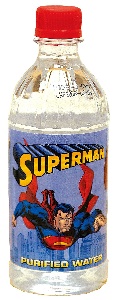 alternative, both for hydration and to fight higher-calorie “healthy” beverage alternatives like juice. Starting next month, another alternative, Kids Only™ Bottled Water, will hit the shelves. Whereas Hint created flavored waters like Apple, Pear and Lime to make the water appealing, the New Kids Only spin is to bottle purified water in collectible bottles decorated with popular kids’ characters, to make drinking plain water more fun. The bottles feature Scooby-Doo, Bratz, Superman and Spiderman, among others. The parent company, Kids Only Toys, produces children’s furniture with licensed characters. With over 15% of today’s children between the ages of six and eleven, are overweight or obese, replacing soft drinks and sweetened juices with water is an essential way to lessen children’s caloric intake. We’re all for it! On May 3rd, the Associated Press ran an article announcing that the top three soda companies have agreed to stop selling soda and sweetened juices in schools. The deal was brokered by the Alliance for a Healthier Generation, a collaboration between the William J. Clinton Foundation and the American Heart Association. (Now, what to do about those French fries?) Kids Only Bottled Water will be available in in 8-ounce-bottle 6-packs for $3.79, 16-ounce four-packs for $2.99, and 16 oz. 6-packs for $3.99. alternative, both for hydration and to fight higher-calorie “healthy” beverage alternatives like juice. Starting next month, another alternative, Kids Only™ Bottled Water, will hit the shelves. Whereas Hint created flavored waters like Apple, Pear and Lime to make the water appealing, the New Kids Only spin is to bottle purified water in collectible bottles decorated with popular kids’ characters, to make drinking plain water more fun. The bottles feature Scooby-Doo, Bratz, Superman and Spiderman, among others. The parent company, Kids Only Toys, produces children’s furniture with licensed characters. With over 15% of today’s children between the ages of six and eleven, are overweight or obese, replacing soft drinks and sweetened juices with water is an essential way to lessen children’s caloric intake. We’re all for it! On May 3rd, the Associated Press ran an article announcing that the top three soda companies have agreed to stop selling soda and sweetened juices in schools. The deal was brokered by the Alliance for a Healthier Generation, a collaboration between the William J. Clinton Foundation and the American Heart Association. (Now, what to do about those French fries?) Kids Only Bottled Water will be available in in 8-ounce-bottle 6-packs for $3.79, 16-ounce four-packs for $2.99, and 16 oz. 6-packs for $3.99.
*Hint Kids flavors proved so popular with adults too, and vice versa for the adult flavors, that Hint rolled the kids line into the main line earlier this year.
7.3.06
A Snowy Celebration. Snow, a sparkling mint beverage, celebrates its first anniversary this month. The all-natural soft drink combines peppermint and spearmint 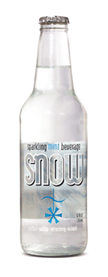 with other natural flavors in order, according to Snow Beverages founder and president Stu Strumwasser, “to create a light, refreshing drink that literally feels like snow melting on your tongue.” While we can’t quite relate that poetic expression to the cold, flavorless purity of the fresh snow we have tasted, we actually grew to like Snow. The first time we tasted it was with food, and it didn’t work for us. It’s an aperitif or refreshment drink than a food beverage. We find it has anise and herbal notes and is a bit like a non-alcoholic Ricard. Like most of the specialty soft drinks, Snow is lower in sugar, containing just 65 calories per 8 ounce serving. Snow is sold at clubs, fine eateries, and upscale grocers across the U.S. and should be available in most major U.S. markets by the end of 2006. It can also be purchased on the company’s website, SnowBeverages.com: a twelve-pack of twelve-ounce bottles is $22.99. with other natural flavors in order, according to Snow Beverages founder and president Stu Strumwasser, “to create a light, refreshing drink that literally feels like snow melting on your tongue.” While we can’t quite relate that poetic expression to the cold, flavorless purity of the fresh snow we have tasted, we actually grew to like Snow. The first time we tasted it was with food, and it didn’t work for us. It’s an aperitif or refreshment drink than a food beverage. We find it has anise and herbal notes and is a bit like a non-alcoholic Ricard. Like most of the specialty soft drinks, Snow is lower in sugar, containing just 65 calories per 8 ounce serving. Snow is sold at clubs, fine eateries, and upscale grocers across the U.S. and should be available in most major U.S. markets by the end of 2006. It can also be purchased on the company’s website, SnowBeverages.com: a twelve-pack of twelve-ounce bottles is $22.99.
Chip, Chip, Hooray: Healthier Snacking! Madhouse Munchies, the Vermont-based chip company, plans to produce their Kettle Cooked Potato Chips in 100-calorie packages for easy portion control. A healthy chip pioneer since 1996, Madhouse hand-cooks each batch in 100 percent high monounsaturated canola oil, and their chips contain no trans fats, cholesterol, or hydrogenated oils. The result is an all-natural, preservative-free product that contains only 0.5 grams of saturated fat per one ounce serving, as opposed to 3.1 grams for an average salted potato chip. The 100-calorie packages will not be available until the late summer or early fall, but you can still purchase the chips in 1.5 ounce, 5 ounce, or 16 ounce bags. The chips are available in four flavors: All-American Sea Salted, Fire Sweet Mesquite BBQ, Sea Salted and Vinegar and Creamy French Onion. They cost between $1.25 and $4.99, depending on bag size, and can be purchased on the company’s website MadhouseMunchies.com, or in grocery stores nationwide.
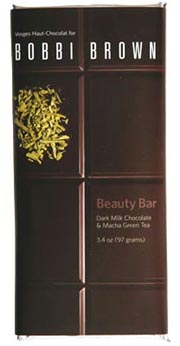 Celebrity Chocolate Bars. First it was Jacques Torres making a line of “beauty” chocolate bars for Estee Lauder’s Origins cosmetics line (and they are delicious). Now it’s the reverse: beauty queen Bobbi Brown is lending her name to Vosges Haut Chocolat’s new Bobbi Brown Beauty Bar, a limited-edition dark milk chocolate blended with matcha green tea + dark milk chocolate. Dark chocolate is one of the highest-antioxidant foods on earth; green tea, while it doesn’t have the same high level, has the beneficial EGCGs which have been shown to have many health benefits. Read our Guide To Antioxidant Foods for more information. The Bobbi Brown Beauty Bars are available at Vosges Boutiques, select Neiman Marcus locations and at Bergdorf Goodman, as well as from the Vosges website. A 3.4-ounce bar is $6.00, slightly less than Vosges other gourmet bars. Celebrity Chocolate Bars. First it was Jacques Torres making a line of “beauty” chocolate bars for Estee Lauder’s Origins cosmetics line (and they are delicious). Now it’s the reverse: beauty queen Bobbi Brown is lending her name to Vosges Haut Chocolat’s new Bobbi Brown Beauty Bar, a limited-edition dark milk chocolate blended with matcha green tea + dark milk chocolate. Dark chocolate is one of the highest-antioxidant foods on earth; green tea, while it doesn’t have the same high level, has the beneficial EGCGs which have been shown to have many health benefits. Read our Guide To Antioxidant Foods for more information. The Bobbi Brown Beauty Bars are available at Vosges Boutiques, select Neiman Marcus locations and at Bergdorf Goodman, as well as from the Vosges website. A 3.4-ounce bar is $6.00, slightly less than Vosges other gourmet bars.
Imitation Not The Sincerest Form Of Flattery. The nation’s top chefs are no longer flattered to find their original recipes presented at other restaurants as the work of other chefs—generally their former employees. The Wall Street Journal reported last week of a paradigm shift in the former time-honored tradition, citing chefs who retain lawyers and demand license fees when they find their original inventions served elsewhere. Why the change in attitude? These days, when hit restaurants chef celebrity, television appearances, books and cookware lines, imitation is no longer flattery—it’s infringement on the originator’s revenue stream. Many chefs now see their menus and restaurant concepts as their own intellectual property, requiring staff to sign nondisclosure agreements, seeking patents for individual dishes and threatening poachers with lawsuits. Of course, the entire tradition of apprenticeship is learning from your mentor, and all artists are inspired by others—and most like to share. Patenting dishes takes years, plus $5,000 to $15,000 apiece (and only if the U.S. patent office deems it sufficiently unique). And even if it were easier, will chefs have to research recipes in a patented database and consult with attorneys before creating anything new on their menus, for fear of infringing on someone’s patent? There is spontaneous generation. Someone other than Ferràn Adria could have put tuna tartare in tuile “ice cream cones.” Are chefs going to spend years and fortunes suing each other over alleged patent infringement? Unfortunately, recipes themselves can’t be copyrighted. Then, a simpler solution would be to acknowledge the creator on the menu, similar to composers on a music program.
Fluffy and Fido Get Their Own Bottled Water. A line of nutritionally enhanced flavored bottled waters for pets has been introduced under the name Molli’s Choice. The waters are developed using vet-approved formulations and come in such pet-appropriate flavors as beef tenderloin, bacon delight, roasted turkey, roasted chicken and original enhanced purified water. “Research shows that many tap water sources contain levels of chlorine and fluoride that can be harmful to your pets," says Tomas Malave, CEO and Founder of Mollibrands. “That’s why we created Molli’s Choice. It’s a fun, healthful product line that even the most finicky pets will enjoy and benefit from.” Molli's Choice waters are purified, non-carbonated and have no harmful chlorine or fluoride. The waters are enhanced with taurine and calcium, vital to pet health. Before you bark at the idea of bottled water for pets, Malave asks you to consider that 63 percent of households own a pet and spend about $36 billion per year on their four-legged family members. The U.S. bottled water industry is a $9 billion market growing almost 13 percent per year. Since entering the market in the late 1990s, enhanced flavored waters have become one of the fastest growing segments of the beverage industry with annual sales topping $450 million. Mollibrands is betting that pets will be the next beneficiaries of this trend. To paraphrase H.L. Mencken, “No one ever went broke underestimating what the American public will spend their money on.” Visit Mollibrands.com for more information.
Be Brainier About Brain Food. OceansAlive.org is a website dedicated to educating consumers about fish that are healthy for the oceans and safe to eat. You can learn about seafood and your health and fish to avoid. Click here to go directly to the web page where you can print a pocket guide to carry with you to make choices that conserve overfished species—some you wouldn’t think are in peril or not good for you, like Chilean seabass*, Atlantic cod, grouper*, halibut, monkfish, orange roughy*, Atlantic farmed salmon*, skate, snapper, wild sturgeon, imported swordfish*, tilefish* and bluefin tuna* (the asterisk indicates fish that are high in mercury or PCBs to boot. See individual fish pages for more information). The website has lots of other information including fish buying guides and suggestions for substitutions including:
- Wild Alaskan salmon for farmed salmon (Atlantic salmon in U.S. stores and restaurants is always farmed).
- If you live in New England and want to serve cod, serve hook-caught instead of trawl-caught Atlantic cod. If you live on the West Coast, sablefish/black cod is a good replacement.
- Farmed striped bass can be used as a substitute for many species of depleted fish such as Pacific rockfish, groupers, snappers, orange roughy and Patagonian toothfish (often called Chilean seabass).
- Catfish can also be substituted for orange roughy.
For meaty warm-water fish like grouper, try mahi mahi instead.
- Most shrimp production outside the U.S. entails considerable habitat destruction or bycatch. If you want to serve shrimp, California trap-caught spot prawns (also excellent frozen) and northern pink shrimp from Newfoundland are the best choices.
- Dredging or dragging for shellfish can damage the seafloor habitat. Replace dredged mussels, oysters and scallops with farmed shellfish raised off-bottom on ropes or racks.
- U.S.-farmed crawfish make an excellent and less expensive replacement for spiny lobsters, which are overfished in many places.
More Soup for You! Al Yeganeh, who gained notoriety as the inspiration for the “Soup Episode” on Seinfeld, has made his popular soups even easier to enjoy with the introduction of Original Soup Man “heat-n-serve” 15 ounce packages. The premium soups are currently available in five flavors: Al’s Garden Vegetable, Chicken Vegetable, Turkey Chili, Seafood Bisque and Jambalaya. Consumers can vote for the next flavor to debut on the company’s website, OriginalSoupMan.com. Loyal fans of Mr. Yeganeh’s have been lining up since 1984, when he opened Soup Kitchen International at Eighth Avenue and 55th Street in New York City. His empire has since expanded to include 18 locations, with plans to open 1,000 more over the next seven years. The soups are available for purchase on the company’s website and range in price from $5.95 to $9.95, depending on the variety. They can also be found in grocery stores and gourmet markets nationwide.
News Archives
| 2nd Quarter 2006 |
1st Quarter 2006 |
4th Quarter 2005 |
|
|
|
| 3rd Quarter 2005 |
2nd Quarter 2005 |
1st Quarter 2005 |
|
|
|
Send your product news to:
Info - at - TheNibble.com.
Substitute @ for -at-. We use this convention to avoid address-harvesting spam spiders.
Lifestyle Direct Direct, Inc. All rights reserved. Images are the copyright of their respective owners.

|





 Cheddar with its caramel undertones has won Best Of Show. That makes it the best cheese in America, according to the American Cheese Society judges. It’s a limited production cheese, and if you can’t find it locally, it’s available at
Cheddar with its caramel undertones has won Best Of Show. That makes it the best cheese in America, according to the American Cheese Society judges. It’s a limited production cheese, and if you can’t find it locally, it’s available at 
 More Moos From Vermont.
More Moos From Vermont. A team of U.S. and German researchers have found that that flavanol-rich cocoa has circulatory health benefits including brain and cardiovascular blood-flow improvement. Two independent studies, one in a healthy elderly population and another in young healthy women, demonstrate that the consumption of flavanol-rich cocoa can increase blood flow to the brain, according to the Journal of Cardiovascular Pharmacology. The scientists found that the regular consumption of flavanol-rich cocoa resulted in a significant increase in blood flow that may improve vascular function in this postmenopausal women population with higher cardiovascular risk; and in general may also reduce the cascade of events that can lead to vascular damage. Who wouldn’t enjoy a soul-satisfying cup of hot chocolate every morning? Buy top-quality cocoa powder, make a big pot in advance with 1% or 2% milk, use a small amount of sugar (or none at all, and then use artificial sweetener) and heat it in the microwave for 60 seconds. You’ve got flavonoids, calcium, something warm and filling—and grab a quick bowl of cereal while you’re at it.
A team of U.S. and German researchers have found that that flavanol-rich cocoa has circulatory health benefits including brain and cardiovascular blood-flow improvement. Two independent studies, one in a healthy elderly population and another in young healthy women, demonstrate that the consumption of flavanol-rich cocoa can increase blood flow to the brain, according to the Journal of Cardiovascular Pharmacology. The scientists found that the regular consumption of flavanol-rich cocoa resulted in a significant increase in blood flow that may improve vascular function in this postmenopausal women population with higher cardiovascular risk; and in general may also reduce the cascade of events that can lead to vascular damage. Who wouldn’t enjoy a soul-satisfying cup of hot chocolate every morning? Buy top-quality cocoa powder, make a big pot in advance with 1% or 2% milk, use a small amount of sugar (or none at all, and then use artificial sweetener) and heat it in the microwave for 60 seconds. You’ve got flavonoids, calcium, something warm and filling—and grab a quick bowl of cereal while you’re at it.  Now You Can Drink Godiva While You Eat It. If you’d like your latte more upscale and chocolatey, you need only wait a few more days for Godiva Belgian Blends. Beginning July 31 the chic new beverage will be available in Dark Chocolate Mocha, Milk Chocolate Mocha and French Vanilla Latte, in stylish 9.5 fl. oz. glass bottles. You don’t need to go to the chocolate store: they’ll be at convenience stores, supermarkets and other retailers, in singles and four packs. Godiva’s marketing partner is beverage titan Coca-Cola North America. According to a company press release, Godiva Belgian Blends will be marketed as a revitalizing experience “more decadent than just plain coffee.” Decadent—are they sure? In our book, the word “decadent,” which means providing unrestrained gratification, does not apply to a beverage. Enjoying a mocha latte is hardly equivalent to an eating orgy or even polishing off an entire box of Godiva chocolate. Nevertheless, you can probably enjoy a bottle or two of Godiva Belgian Blends without turning into a [truly decadent] character from Fellini’s Satyricon.
Now You Can Drink Godiva While You Eat It. If you’d like your latte more upscale and chocolatey, you need only wait a few more days for Godiva Belgian Blends. Beginning July 31 the chic new beverage will be available in Dark Chocolate Mocha, Milk Chocolate Mocha and French Vanilla Latte, in stylish 9.5 fl. oz. glass bottles. You don’t need to go to the chocolate store: they’ll be at convenience stores, supermarkets and other retailers, in singles and four packs. Godiva’s marketing partner is beverage titan Coca-Cola North America. According to a company press release, Godiva Belgian Blends will be marketed as a revitalizing experience “more decadent than just plain coffee.” Decadent—are they sure? In our book, the word “decadent,” which means providing unrestrained gratification, does not apply to a beverage. Enjoying a mocha latte is hardly equivalent to an eating orgy or even polishing off an entire box of Godiva chocolate. Nevertheless, you can probably enjoy a bottle or two of Godiva Belgian Blends without turning into a [truly decadent] character from Fellini’s Satyricon. like regular chocolate. In taste tests conducted by the Nigerian researchers, people rated the new chocolate as being similar to milk chocolate in color, taste, smoothness and overall acceptability. It was found to be slightly less sweet than milk chocolate, however. (This would be seen as a benefit to dark chocolate-lovers!) However, the Nigerian team isn’t concerned with how it compares against “real” milk chocolate: their target market, which does not have the luxury of air conditioning, currently doesn’t eat chocolate at all.
like regular chocolate. In taste tests conducted by the Nigerian researchers, people rated the new chocolate as being similar to milk chocolate in color, taste, smoothness and overall acceptability. It was found to be slightly less sweet than milk chocolate, however. (This would be seen as a benefit to dark chocolate-lovers!) However, the Nigerian team isn’t concerned with how it compares against “real” milk chocolate: their target market, which does not have the luxury of air conditioning, currently doesn’t eat chocolate at all.  as a breakfast replacement for women on-the-go. While most women are well aware of the importance of a healthy breakfast, a recent national LUNA study showed that one-third skip regularly skip breakfast due to time challenges or lack of healthy choices, and 56 percent of women eat breakfast on-the-run at least twice a week. The 180-calorie LUNA Sunrise bars, in Blueberry Yogurt, Strawberries & Creme and Vanilla Almond, have 8g of protein and 5g of fiber to curb hunger and sustain energy, plus added calcium, folic acid, iron, and antioxidants (vitamins A, C, and E). Each bar contains as much calcium as a glass of milk, plus Vitamin D to help absorb calcium. The bars are made of a unique blend of organic heritage (or heirloom) whole grains including amaranth, quinoa, oats and barley, which contain more nutrients than other whole grains. The bars, which are made with 70 percent organic ingredients, also contain organic flaxseed, which provides Omega 3’s. The bars are available nationwide at grocery, natural, convenience, drug and sports specialty stores with a suggested retail price of $1.29. LUNA is made by the manufacturers of
as a breakfast replacement for women on-the-go. While most women are well aware of the importance of a healthy breakfast, a recent national LUNA study showed that one-third skip regularly skip breakfast due to time challenges or lack of healthy choices, and 56 percent of women eat breakfast on-the-run at least twice a week. The 180-calorie LUNA Sunrise bars, in Blueberry Yogurt, Strawberries & Creme and Vanilla Almond, have 8g of protein and 5g of fiber to curb hunger and sustain energy, plus added calcium, folic acid, iron, and antioxidants (vitamins A, C, and E). Each bar contains as much calcium as a glass of milk, plus Vitamin D to help absorb calcium. The bars are made of a unique blend of organic heritage (or heirloom) whole grains including amaranth, quinoa, oats and barley, which contain more nutrients than other whole grains. The bars, which are made with 70 percent organic ingredients, also contain organic flaxseed, which provides Omega 3’s. The bars are available nationwide at grocery, natural, convenience, drug and sports specialty stores with a suggested retail price of $1.29. LUNA is made by the manufacturers of  released by Packaged Facts. Gluten-free products have seen sales soar in recent years due to an increase in the number of individuals diagnosed with Celiac disease, a gluten intolerance illness. The market had an annual compound growth rate of 27 percent from 2001 to 2006, a rate that is forecasted to drop slightly to 25 percent through 2010. A lack of set regulations for gluten-free products has kept some manufacturers from entering the industry, but more activity is anticipated when the FDA releases its definition of “gluten-free” in 2008. The demand for gluten-free foods was evident at the Fancy Food Show, where new specialty foods producers of gluten-free crackers and cake mixes exhibited for the first time; and many other products, including those which traditionally have no grain in them (like jam, ice cream and soda) proclaimed “gluten-free” on the front of their packages. Shown above is one of our top picks from the Fancy Food show, the chocolate chip cookies from
released by Packaged Facts. Gluten-free products have seen sales soar in recent years due to an increase in the number of individuals diagnosed with Celiac disease, a gluten intolerance illness. The market had an annual compound growth rate of 27 percent from 2001 to 2006, a rate that is forecasted to drop slightly to 25 percent through 2010. A lack of set regulations for gluten-free products has kept some manufacturers from entering the industry, but more activity is anticipated when the FDA releases its definition of “gluten-free” in 2008. The demand for gluten-free foods was evident at the Fancy Food Show, where new specialty foods producers of gluten-free crackers and cake mixes exhibited for the first time; and many other products, including those which traditionally have no grain in them (like jam, ice cream and soda) proclaimed “gluten-free” on the front of their packages. Shown above is one of our top picks from the Fancy Food show, the chocolate chip cookies from  chips, Kettle™ Brand, is about to move into new territory—pretzel land—with a line of Bakes Pretzel Chips, flat-shaped baked pretzels (actually, the same curved shape as their potato chips), made with organic flour. Three flavors, Original, Fully Loaded (think of an “everything” bagel) and Honey Dijon debuted to the trade at Expo West, the industry’s largest natural products show, in April and will be showing up on store shelves this month. We think they’re a great idea, combining excellent pretzel flavor with a perfect shape for dipping. Our favorite flavor, Honey Dijon, actually requires no dip—it tastes as delicious as a pretzel dipped in honey mustard—and there’s no mustard to drip on anything!
chips, Kettle™ Brand, is about to move into new territory—pretzel land—with a line of Bakes Pretzel Chips, flat-shaped baked pretzels (actually, the same curved shape as their potato chips), made with organic flour. Three flavors, Original, Fully Loaded (think of an “everything” bagel) and Honey Dijon debuted to the trade at Expo West, the industry’s largest natural products show, in April and will be showing up on store shelves this month. We think they’re a great idea, combining excellent pretzel flavor with a perfect shape for dipping. Our favorite flavor, Honey Dijon, actually requires no dip—it tastes as delicious as a pretzel dipped in honey mustard—and there’s no mustard to drip on anything!  international ban on caviar exports. Sterling Caviar, a sturgeon farm based in Sacramento County, California, plans on producing 18,000 pounds of caviar this year. Twelve years ago, the company was harvesting just thirty pounds annually. California has great potential as a farmed caviar-producing region, as its climate allows for caviar to be harvested several times a year, as opposed to just during the spring (warm temperatures are required for the harvest). Though the quality of California caviar is very good, it’s not anything like beluga…yet. As more money and research is introduced into American caviar production, its value in terms of both price and taste is sure to increase. To find out everything else you’ve ever wanted to know about buying and serving caviar,
international ban on caviar exports. Sterling Caviar, a sturgeon farm based in Sacramento County, California, plans on producing 18,000 pounds of caviar this year. Twelve years ago, the company was harvesting just thirty pounds annually. California has great potential as a farmed caviar-producing region, as its climate allows for caviar to be harvested several times a year, as opposed to just during the spring (warm temperatures are required for the harvest). Though the quality of California caviar is very good, it’s not anything like beluga…yet. As more money and research is introduced into American caviar production, its value in terms of both price and taste is sure to increase. To find out everything else you’ve ever wanted to know about buying and serving caviar, 
 alternative, both for hydration and to fight higher-calorie “healthy” beverage alternatives like juice. Starting next month, another alternative, Kids Only™ Bottled Water, will hit the shelves. Whereas Hint created flavored waters like Apple, Pear and Lime to make the water appealing, the New Kids Only spin is to bottle purified water in collectible bottles decorated with popular kids’ characters, to make drinking plain water more fun. The bottles feature Scooby-Doo, Bratz, Superman and Spiderman, among others. The parent company,
alternative, both for hydration and to fight higher-calorie “healthy” beverage alternatives like juice. Starting next month, another alternative, Kids Only™ Bottled Water, will hit the shelves. Whereas Hint created flavored waters like Apple, Pear and Lime to make the water appealing, the New Kids Only spin is to bottle purified water in collectible bottles decorated with popular kids’ characters, to make drinking plain water more fun. The bottles feature Scooby-Doo, Bratz, Superman and Spiderman, among others. The parent company,  with other natural flavors in order, according to Snow Beverages founder and president Stu Strumwasser, “to create a light, refreshing drink that literally feels like snow melting on your tongue.” While we can’t quite relate that poetic expression to the cold, flavorless purity of the fresh snow we have tasted, we actually grew to like Snow. The first time we tasted it was with food, and it didn’t work for us. It’s an aperitif or refreshment drink than a food beverage. We find it has anise and herbal notes and is a bit like a non-alcoholic Ricard. Like most of the specialty soft drinks, Snow is lower in sugar, containing just 65 calories per 8 ounce serving. Snow is sold at clubs, fine eateries, and upscale grocers across the U.S. and should be available in most major U.S. markets by the end of 2006. It can also be purchased on the company’s website, SnowBeverages.com: a twelve-pack of twelve-ounce bottles is $22.99.
with other natural flavors in order, according to Snow Beverages founder and president Stu Strumwasser, “to create a light, refreshing drink that literally feels like snow melting on your tongue.” While we can’t quite relate that poetic expression to the cold, flavorless purity of the fresh snow we have tasted, we actually grew to like Snow. The first time we tasted it was with food, and it didn’t work for us. It’s an aperitif or refreshment drink than a food beverage. We find it has anise and herbal notes and is a bit like a non-alcoholic Ricard. Like most of the specialty soft drinks, Snow is lower in sugar, containing just 65 calories per 8 ounce serving. Snow is sold at clubs, fine eateries, and upscale grocers across the U.S. and should be available in most major U.S. markets by the end of 2006. It can also be purchased on the company’s website, SnowBeverages.com: a twelve-pack of twelve-ounce bottles is $22.99.  Celebrity Chocolate Bars.
Celebrity Chocolate Bars.